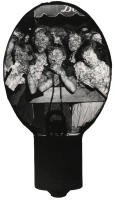In May of last year, MIT’s Kurtz Gallery for Photography opened with its first exhibition featuring Berenice Abbott. Abbott was hired by MIT to develop photographic imagery for the teachings of physics and spent two years using photography to document the principles of physical science–mechanics, electromagnetism, and waves.
Berenice Abbott, A Bouncing Ball in Diminishing Arcs, 1958-61 (24.1986)
Photographing movement has always been a challenging task. In the early developments of photography, pictures involving motion were often taken in the middle of a bright, sunny day, to allow for the fast shutter speeds. While working for German and Hungarian newspapers, Hungarian-born Martin Munkacsi developed an interest in movement, and developed an expertise in sports photography. Below, in a picture from his series involving acrobatic dancers, Munkacsi captures his subject mid-air, with arms raised, hair flying, and legs extended from her gigantic leap off the raised ladder.
Martin Munkacsi, [Tibor von Halmay and Vera Mahlke], ca. 1931 (2007.110.842)
Winogrand captures a similar moment of women in flight–cheerleaders synchronizing in their performance at a basketball game.
Garry Winogrand, Austin, Texas, from the Women are Beautiful series, 1975 (263.1984)




